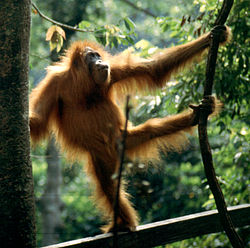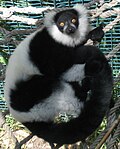Portal:Primates
The Primates Portal A primate is a member of the biological order Primates, the group that contains lemurs, the aye-aye, lorisids, galagos, tarsiers, monkeys, and apes, with the last category including great apes. With the exception of humans, who inhabit every continent on Earth, most primates live in tropical or subtropical regions of the Americas, Africa and Asia. Primates range in size from the 30-gram (1 oz) pygmy mouse lemur to the 200-kilogram (440 lb) mountain gorilla. According to fossil evidence, the primitive ancestors of primates may have existed in the late Cretaceous period around 65 mya (million years ago), and the oldest known primate is the Late Paleocene Plesiadapis, c. 55–58 mya. Molecular clock studies suggest that the primate branch may be even older, originating in the mid-Cretaceous period around 85 mya. Primates exhibit a wide range of characteristics. Some primates do not live primarily in trees, but all species possess adaptations for climbing trees. Locomotion techniques used include leaping from tree to tree, walking on two or four limbs, knuckle-walking, and swinging between branches of trees (known as brachiation). Primates are characterized by their large brains relative to other mammals. These features are most significant in monkeys and apes, and noticeably less so in lorises and lemurs. Many species are sexually dimorphic, which means males and females have different physical traits, including body mass, canine tooth size, and coloration.
Selected article
Humans are bipedal primates belonging to the species Homo sapiens (Latin: "wise man" or "knowing man") in Hominidae, the great ape family. They are the only surviving member of the genus Homo. Humans have a highly developed brain, capable of abstract reasoning, language, introspection, and problem solving. This mental capability, combined with an erect body carriage that frees the arms for manipulating objects, has allowed humans to make far greater use of tools than any other species. Mitochondrial DNA and fossil evidence indicates that modern humans originated in Africa about 200,000 years ago. Humans now inhabit every continent and low Earth orbit, with a total population of over 6.7 billion as of September 2009.
Like most higher primates, humans are social by nature. However, humans are uniquely adept at utilizing systems of communication for self-expression, the exchange of ideas, and organization. Humans create complex social structures composed of many cooperating and competing groups, from families to nations. Social interactions between humans have established an extremely wide variety of values, social norms, and rituals, which together form the basis of human society. Humans have a marked appreciation for beauty and aesthetics which, combined with the human desire for self-expression, has led to cultural innovations such as art, literature and music. Humans are noted for their desire to understand and influence their environment, seeking to explain and manipulate natural phenomena through science, philosophy, mythology and religion. This natural curiosity has led to the development of advanced tools and skills, which are passed down culturally; humans are the only extant species known to build fires, cook their food, clothe themselves, and use numerous other technologies. Selected picture Emperor tamarins inhabit tropical rain forests, living deep in the forest and also in open tree-covered areas. This diurnal species walks or runs quadrupedally through the forest, spending the majority of its days in the trees with quick, safe movements and broad jumps among the limbs. CategoriesSelected species Critically Endangered (IUCN 3.1)|Critically endangered Gerp's mouse lemur (Microcebus gerpi) is a species of mouse lemur known only from the Sahafina forest in eastern Madagascar, near Mantadia National Park. Its discovery was announced in 2012 by a German and Malagasy research team. Based on genetic studies, measurements, and photos, the research team confirmed that Gerp's mouse lemur was an undescribed species, distinct from Goodman's mouse lemur, which is found 58 kilometers (36 mi) away. Gerp's mouse lemur is significantly larger, weighing on average 68 grams (2.4 oz), compared to Goodman's mouse lemur, which weighs approximately 44 g (1.6 oz). Jolly's mouse lemur, which is its closest relative and a neighbor to the south, is comparably large, but differs in tail length and genetics. Because it is a recently discovered species, nothing is known about its behavior, communication, ecology, or reproduction. The species appears to be restricted to a small region of lowland evergreen rain forest, and is seriously threatened by forest loss. Did you know?
Primate lists
WikiProjectsThings to do
Associated WikimediaDiscover Wikipedia using portals
|

















